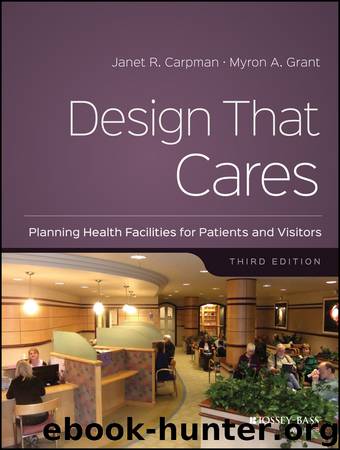Design That Cares by Carpman Janet R.; Grant Myron A.; & Myron A. Grant

Author:Carpman, Janet R.; Grant, Myron A.; & Myron A. Grant
Language: eng
Format: epub
ISBN: 9780787988111
Publisher: John Wiley & Sons, Incorporated
Published: 2016-03-28T00:00:00+00:00
Reducing Noise in ICUs
Common noises in the ICU include staff conversations, beeps and alarms, ringing telephones, and movement of equipment. Noise can make it difficult for patients to sleep and can lead to increased heart rates even while sleeping (Bakalar, 2008; Cmiel et al., 2004; Haslam, 1970; Storlie, 1976). Sleep deprivation in ICU patients has been found to contribute to impaired immune functioning, ventilation or breathing problems, and delirium (Cmiel et al., 2004; Parthasarathy and Tobin, 2004; Topf, Bookman, and Arand, 1996; Wallace et al., 1999). Adverse effects on the respiratory system may interfere with the weaning of patients from mechanical ventilation (Meyer et al., 1994). Noise may contribute to these negative health effects; however, it is difficult to determine the degree to which negative health effects are specifically due to noise.
Noise-related problems are further complicated by the fact that the effects of noise depend on its frequency and on the sensitivity of individual listeners. Sounds that annoy one patient may be stimulating or comforting to another (Hewitt, 2002; Redding, Hargest, and Minsky, 1976). For example, some patients reported finding comfort in hearing conversations and footsteps of the nurses (Hewitt, 2002). For some, the usual noises of conversations and traffic may help orient them and reduce confusion (Hewitt, 2002). In general, hospitals tend to be noisy places, with conditions not conducive to the restful, restorative atmosphere needed by most patients.
According to the US Environmental Protection Agency (EPA), recommended upper limits on continuous sound levels for hospitals are an average of 45 decibels or fewer over a 24-hour period (Public Health, Madison and Dane County, 2013; Topf, 1983). For sleeping conditions, the EPA and the World Health Organization (WHO) recommend 35 decibels (Balogh et al., 1993; Cmiel et al., 2004). An expert panel at the National Institutes of Health (NIH) Consensus Development Conference in 1990 reported that sounds at or above 85 decibels are potentially hazardous for hearing. Most permanent hearing loss is a result of exposures to sound levels over 85 decibels for eight hours a day over many years or a single exposure to abrupt sounds at high decibel levels (Noise and Hearing Loss, 1990).
Some examples of everyday noise levels are listed here to help put the EPA, WHO, and NIH standards in perspective (every 10-decibel increase is perceived by the human ear as being about twice as loud) (Cmiel et al., 2004; US Environmental Protection Agency, 1974):
– Rush hour traffic: 90 decibels
– Cafeteria at noon: 75 decibels
– Radio at full volume: 60 decibels
– Normal conversation: 60 decibels
– Whispering: 30 decibels
Download
This site does not store any files on its server. We only index and link to content provided by other sites. Please contact the content providers to delete copyright contents if any and email us, we'll remove relevant links or contents immediately.
Good by S. Walden(3388)
The Social Psychology of Inequality by Unknown(2824)
The Checklist Manifesto by Atul Gawande(2692)
0041152001443424520 .pdf by Unknown(2674)
The Meaning of the Library by unknow(2435)
Guns, Germs and Steel by Diamond Jared(2217)
23:27 by H. L. Roberts(2153)
Borders by unknow(2129)
Being Mortal: Medicine and What Matters in the End by Atul Gawande(2047)
And the Band Played On by Randy Shilts(2040)
A Leg to Stand On by Oliver Sacks(1944)
The Hot Zone by Richard Preston(1925)
The Valachi Papers by Peter Maas(1774)
Get What's Yours for Medicare: Maximize Your Coverage, Minimize Your Costs by Philip Moeller(1738)
The Laws of Medicine by Siddhartha Mukherjee(1701)
The Andromeda Strain by Michael Crichton(1651)
The Obesity Epidemic by Robyn Toomath(1615)
Pharmacy Practice and The Law by Richard Abood(1505)
The Plague and I by Betty Macdonald(1461)
